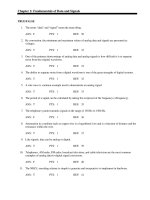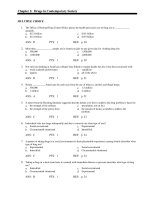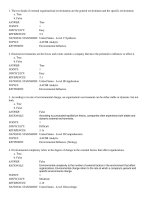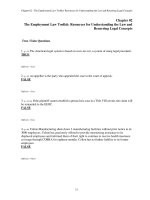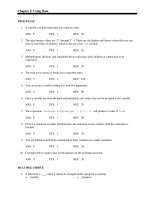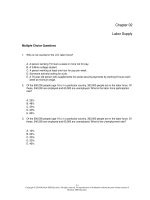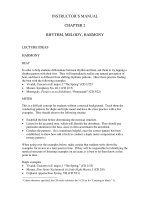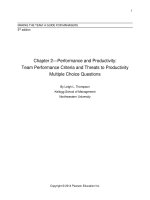Drugs across the spectrum 7th edition raymond goldberg test bank
Bạn đang xem bản rút gọn của tài liệu. Xem và tải ngay bản đầy đủ của tài liệu tại đây (217.25 KB, 9 trang )
Chapter 2: Drugs in Contemporary Society
MULTIPLE CHOICE
1. The Office of National Drug Control Policy places the health and social cost of drug use at ____________
annually.
a. $121 billion
b. $141 billion
ANS: D
c. $161 billion
d. $193 billion
PTS: 1
REF: p. 20
2. More than _____________ people are in American jails on any given day for violating drug law.
a. 500,000
c. 1,500,000
b. 1,000,000
d. 2,000,000
ANS: A
PTS: 1
REF: p. 20
3. Not only has drinking at American colleges been linked to student deaths but also it has been associated with
a. weak academic performance
c. vandalism
injuries
b.
d. all of the above
ANS: D
PTS: 1
REF: p. 21
4. Nearly __________ Americans die each year from the use of tobacco, alcohol, and illegal drugs.
a. 500,000
c. 1.5 million
b. 1 million
d. 2 million
ANS: A
PTS: 1
REF: p. 21
5. A report from the Brooking Institute suggested that the debate over how to address the drug problem is based on
a. the strength of the military
c. speculation, not on fact
b. the strength of the police force
d. the amount of money available to address the
problem
ANS: C
PTS: 1
REF: p. 23
6. Individuals who use drugs infrequently and due to curiosity are what type of user?
a. Social-recreational
c. Experimental
Circumstantial-situational
b.
d. Intensified
ANS: C
PTS: 1
REF: p. 24
7. A pattern of taking drugs in a social environment to share pleasurable experiences among friends describes what
type of drug use?
a. Experimental
b. Intensified
ANS: C
c. Social-recreational
d. Circumstantial-situational
PTS: 1
REF: p. 24
8. Taking a drug on a short-term basis to contend with immediate distress or pressure describes what type of drug
use?
a. Intensified
b. Circumstantial-situational
ANS: B
PTS: 1
c. Social-recreational
d. Experimental
REF: p. 24
9. When a person uses drugs on a steady, long-term basis to achieve relief from a persistent problem, what kind of
use is this?
a. Intensified
b. Compulsive
ANS: A
c. Circumstantial-situational
d. Social-recreational
PTS: 1
REF: p. 24
10. What type of drug use refers to the user’s lifestyle revolving around drugs?
a. Intensified
c. Social-recreational
b. Compulsive
d. Circumstantial-situational
ANS: B
PTS: 1
REF: p. 24
11. Data regarding drug use has been collected periodically from U.S. households since what year?
a. 1951
c. 1971
b. 1961
d. 1981
ANS: C
PTS: 1
REF: p. 25
12. According to the National Survey on Drug Use and Health, the highest rate of binge drinking and the highest rate
of heavy drinking were in which age group?
a. 18-21
b. 18-25
ANS: B
PTS: 1
c. 21-30
d. 25-35
REF: p. 25
13. According to the 2010 Monitoring the Future study, which of the following drugs showed a decline in use?
a. Marijuana
c. Cocaine
Amphetamines
b.
d. All of the above
ANS: D
PTS: 1
REF: p. 27
14. Drug abuse by Americans aged 60 years and older has been referred to as
a. geriatric psychotropic effect
c. pharmaceutical pandemic
b. gerontology syndrome
d. invisible epidemic
ANS: D
PTS: 1
16. Substance abuse in the workplace may result in
a. increased accidents
b. increased health care costs
ANS: D
PTS: 1
REF: p. 28
c. increased absenteeism
d. all of the above
REF: p. 29
17. It is estimated that employee drug abuse costs the workplace
a. $15 billion
c. $27.9 billion
b. $25.6 billion
d. $30 billion
ANS: B
PTS: 1
REF: p. 29
18. Most surveys showed that less than _______ of workers used alcohol or other drugs on the job.
a. 3%
c. 7%
b. 5%
d. 10%
ANS: D
PTS: 1
REF: p. 29
19. Many corporations have devised EAPs to help workers deal with __________ problems that affect job
performance.
a. legal
b. family
ANS: D
c. health
d. all of the above
PTS: 1
20. Most Americans view drug testing as
a. degrading and dehumanizing
b. important and valuable
ANS: A
PTS: 1
REF: p. 30
c. a necessary procedure
d. illegal
REF: p. 31
21. Which of the following is a fast and inexpensive test used in a drug screening?
a. Gas chromatography
c. Thin-layer chromatography
b. Immunoassay
d. None of the above
ANS: B
PTS: 1
REF: p. 32
22. When a person tests positive for a drug even though there was no drug present in the body, it is termed
a. inaccurate
c. false positive
false
negative
b.
d. positive outlier
ANS: C
PTS: 1
REF: p. 32
23. When a person tests negative for a drug even though that drug is present in the body, it is termed
a. negative outlier
c. false positive
false
negative
b.
d. inaccurate
ANS: B
PTS: 1
REF: p. 32
24. Family interventions into adolescent alcohol use reduce the initiation and __________ of alcohol use.
a. cost
c. amount
b. frequency
d. duration
ANS: B
PTS: 1
REF: p. 33
25. The most important distinction between drug users and non-users is the extent of
a. their response to family problems
c. use of legal substances
b. their responses to peer pressure
d. conventionality
ANS: D
PTS: 1
26. Heroin is linked to criminal behavior, but NOT
a. violent behavior
b. family problems
ANS: A
PTS: 1
REF: p. 34
c. community problems
d. financial problems
REF: p. 34
27. The drug involved with the most violent incidents is
a. heroin
c. alcohol
b. amphetamines
d. LSD
ANS: C
PTS: 1
28. Which term refers to a drug being poisonous?
a. Addiction
REF: p. 34
c. Habituation
b. Dependence
ANS: D
d. Toxic
PTS: 1
REF: p. 35
29. The difference between a safe and dangerous level of a drug is termed
a. therapeutic index
c. therapeutic safety coefficient
b. margin of safety
d. safety coefficient
ANS: B
PTS: 1
REF: p. 35
30. What type of toxicity refers to a drug’s interference in one’s ability to function?
a. Acute
c. Physiological
Chronic
b.
d. Behavioral
ANS: D
PTS: 1
REF: p. 35
31. Which type of toxicity alludes to the danger from a single experimentation with the drug?
a. Chronic
c. Physiological
Acute
b.
d. Intensified
ANS: B
PTS: 1
REF: p. 35
32. Which of the following refers to the toxicity danger resulting from repeated use of a drug?
a. Acute
c. Physiological
b. Intensified
d. Chronic
ANS: D
PTS: 1
REF: p. 35
33. The federal government monitors the rate of emergency room visits and fatal overdoses due to drugs through a
network called
a. FBIN
b. DEA
ANS: C
c. DAWN
d. ATF
PTS: 1
34. The data in DAWN reports reflects
a. chronic overdoses
b. acute drug-related problems
ANS: B
PTS: 1
REF: p. 35
c. only alcohol-related problems
d. only those needed to be hospitalized
REF: p. 36
35. Synthetic substances chemically similar to existing drugs are referred to as
a. look-alike drugs
c. designer drugs
b. sound-alike drugs
d. quasi-synthetic drugs
ANS: C
PTS: 1
36. Cathinone is another name for
a. bath salts
b. Ecstasy
ANS: A
PTS: 1
37. Which of the following is a designer drug?
a. Heroin
b. MDMA
REF: p. 36
c. cannabinoids
d. fentanyl
REF: p. 37
c. Wine coolers
d. Crack
ANS: B
PTS: 1
REF: p. 37
38. __________ is a synthetic derivative of morphine.
a. MDMA
c. Meperidine
Ecstasy
b.
d. MDA
ANS: C
PTS: 1
REF: p. 37
39. Tactics for stopping the flow of drugs into the United States have proved
a. effective
c. cost effective
b. ineffective
d. positive
ANS: B
PTS: 1
40. Biphetamine is also known as
a. the love drug
b. the date rape drug
ANS: D
PTS: 1
REF: p. 39
c. herbal ecstasy
d. black widow
REF: p. 39
41. Political leaders from Central America have pledged to intercede in the drug trade, but the security forces in
many of these countries are hampered by
a. lack of funds
b. lack of access to good weapons
ANS: C
PTS: 1
c. internal corruption
d. lack of technology
REF: p. 40
42. Preventing drugs from entering the United States or reducing the amount of drugs grown in the country is
a. hampered by a lack of technology
c. largely a military effort
b. a matter of demand, not supply
d. best done by local police
ANS: B
PTS: 1
REF: p. 41
MATCHING
a.
b.
c.
d.
e.
1.
2.
3.
4.
5.
6.
7.
8.
9.
Experimental drug use
Social-recreational use
Circumstantial use
Intensified use
Compulsive use
f.
g.
h.
i.
Physiological toxicity
Behavioral toxicity
Acute toxicity
Chronic toxicity
Short-term use to relieve immediate distress
Infrequent use motivated by curiosity
Drug use on a steady basis to relieve problems
Drug use to share experiences
Obsessive drug use
Harm arising from drug’s interference with one’s ability to function
Harm with single use
Harm with repeated use
Physical harm due directly to drug use
1. ANS: C
2. ANS: A
PTS: 1
PTS: 1
3.
4.
5.
6.
7.
8.
9.
ANS:
ANS:
ANS:
ANS:
ANS:
ANS:
ANS:
D
B
E
G
H
I
F
PTS:
PTS:
PTS:
PTS:
PTS:
PTS:
PTS:
1
1
1
1
1
1
1
TRUE/FALSE
1. Nearly every American has used a mind-altering substance.
ANS: T
PTS: 1
2. Nearly 500,000 Americans die each year from use of tobacco, alcohol and illegal
drugs.
ANS: T
PTS: 1
3. The age group most likely to use drugs is 25- to 34-year-olds.
ANS: F
PTS: 1
4. The constitutionality of drug testing has been answered definitively.
ANS: F
PTS: 1
5. Monitoring the Future refers to a drug treatment program.
ANS: F
PTS: 1
6. Biphetamine is also referred to as “black widow.”
ANS: T
PTS: 1
7. EAPs help workers deal with personal problems.
ANS: T
PTS: 1
8. There is a strong relationship between drug use and deviant attitudes and behavior.
ANS: T
PTS: 1
9. Heroin is linked to violent behavior, but not necessarily criminal behavior.
ANS: F
PTS: 1
10. There is a clear connection between crime and drugs.
ANS: T
PTS: 1
11. Drugs use reinforces a lack of interest in educational pursuits.
ANS: T
PTS: 1
12. Marijuana users have better school attendance rates than nonusers.
ANS: F
PTS: 1
13. It is unclear whether job instability results in drug use or whether drug use causes job instability.
ANS: T
PTS: 1
14. Toxicity does not reflect the legal status of a drug.
ANS: T
PTS: 1
15. DAWN information is collected from every hospital in the United States.
ANS: F
PTS: 1
16. DAWN data cites alcohol as a single drug entry.
ANS: F
PTS: 1
17. Designer drugs contain primarily over-the-counter substances.
ANS: F
PTS: 1
18. MDMA is generally viewed as a safe drug.
ANS: F
PTS: 1
19. Smoking or inhaling bath salts are often compared to ecstasy.
ANS: T
PTS: 1
20. Fentanyl is a stimulant.
ANS: F
PTS: 1
ESSAY
1. Discuss the impact of drug use and abuse.
ANS:
Drug use is destroying the fabric of society
Families and communities are undermined by drug use
Majority of Americans view drugs as an extremely serious problem
Illegal drug use has a connection to crime
PTS: 1
REF: p. 21-23
2. Discuss the key social implications of the results of the National Survey on Drug Use and Health.
ANS:
Males had higher rates of drug use than females
Highest rate of illegal drug use was in the 18- to 25-year-old age group
Blacks had the highest monthly rate of illicit drug use
28.8 million people have driven in a car under the influence of alcohol
PTS: 1
REF: P. 25-26
3. What are the consequences of drug use on the family, education, and employment?
ANS:
Drug use is associated with divorce
Drug use is a factor in family stability
There is a higher dropout rate from school for those who use alcohol, illicit drugs, and cigarettes
Employed drug users have less stable job histories than nonusers
Drug use is associated with higher accident rates on the job and lower productivity
PTS: 1
REF: p. 33-35
SHORT ANSWER
1. How have drugs impacted American families, culture, and politics? What examples can you cite that support
your response?
ANS:
No Answer Given
PTS: 1
2. Do you think drug testing should be instituted at all organization levels — workplace and school? What would it
accomplish?
ANS:
No Answer Given
PTS: 1
3. How is DAWN helpful? What other things might be done to complement DAWN and how would they help?
ANS:
No Answer Given
PTS: 1
